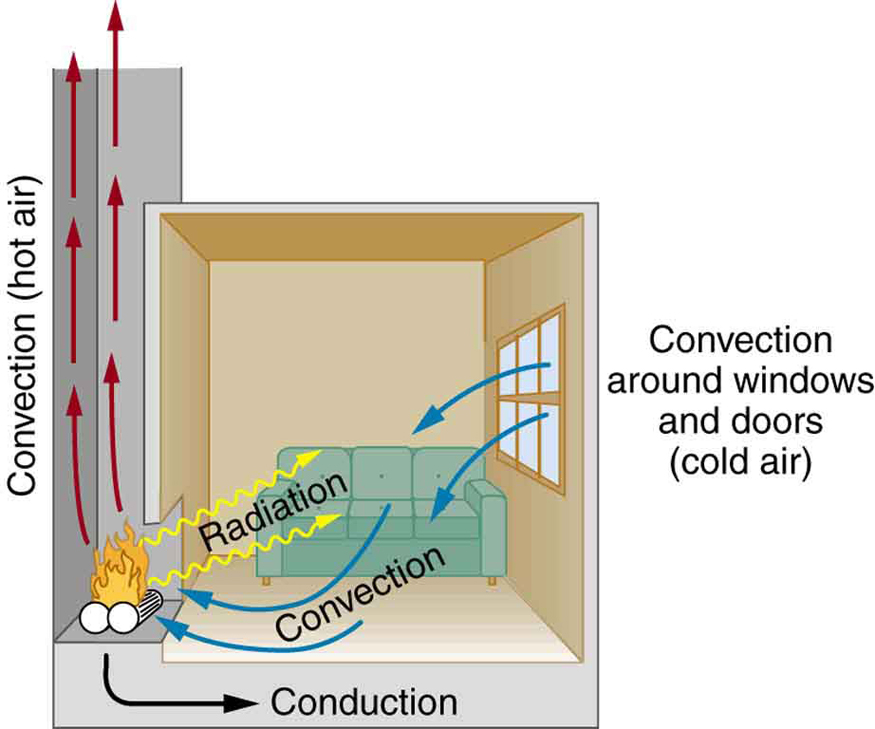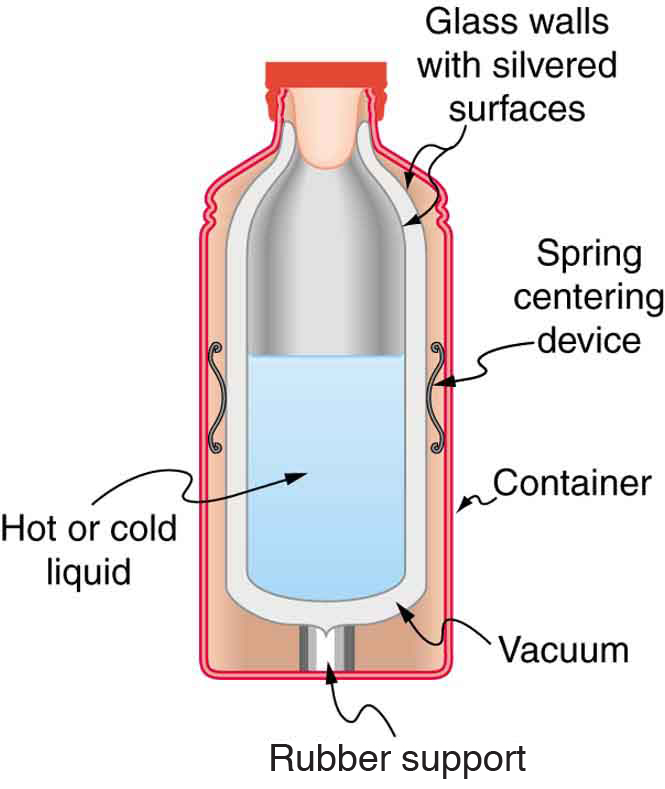Heat and Heat Transfer Methods
103 Heat Transfer Methods
Learning Objectives
- Identify and describe the different mechanisms of heat transfer.
Understanding how heat moves is as important as understanding what heat does. Whenever a temperature difference exists, heat flows. This can happen quickly, like when a hot pan warms your hand through a metal handle, or slowly, like when heat seeps through the insulation of a cooler. We manage heat transfer in everyday life—by choosing insulating materials (like winter jackets), limiting air movement (with weather stripping), or using reflective surfaces (such as white roofs to stay cool in summer).
Remarkably, all heat transfer occurs through just three basic mechanisms:
- Conduction: Heat transfer through direct contact in stationary matter. For example, the bottom of a metal pot in contact with a hot stove transfers energy via particle collisions from hot to cold regions.
- Convection: Heat transfer through the bulk motion of fluids (liquids or gases). This happens in boiling water, blood circulation, and weather systems.
- Radiation: Heat transfer via electromagnetic waves (like infrared radiation or visible light). Radiation doesn’t need a medium—it can travel through the vacuum of space, as when the Sun warms the Earth.

Each of these mechanisms has distinct properties, but all transfer heat as a result of temperature differences (see Figure 103.1). In the upcoming modules, we’ll examine conduction, convection, and radiation in greater detail, including how they apply to biological systems like skin, blood flow, and metabolism.
Check Your Understanding
Question: Name one example from daily life—not mentioned above—for each mechanism of heat transfer.
Answer:
- Conduction: Heat transfers into your hands when holding a metal spoon left in a hot soup bowl.
- Convection: Warm air rising from a car heater spreads heat throughout the vehicle interior.
- Radiation: Feeling the warmth from the Sun on your skin on a clear day.
Summary
- Heat transfer always results from a temperature difference and occurs via one or more of three methods: conduction (contact), convection (fluid motion), and radiation (electromagnetic waves).
Conceptual Questions
- What are the main methods of heat transfer from the hot core of Earth to its surface? From Earth’s surface to outer space?
- When our bodies get too warm, they respond by sweating and increasing blood circulation to the surface to transfer thermal energy away from the core. What effect will this have on a person in a [latex]\text{40}\text{.}\text{0ºC}[/latex] hot tub?
- Figure 103.2 shows a cut-away drawing of a thermos bottle (also known as a Dewar flask), which is a device designed specifically to slow down all forms of heat transfer. Explain the functions of the various parts, such as the vacuum, the silvering of the walls, the thin-walled long glass neck, the rubber support, the air layer, and the stopper.

Figure 103.2 The construction of a thermos bottle is designed to inhibit all methods of heat transfer.
Glossary
- conduction
- heat transfer through stationary matter by physical contact
- convection
- heat transfer by the macroscopic movement of fluid
- radiation
- heat transfer which occurs when microwaves, infrared radiation, visible light, or other electromagnetic radiation is emitted or absorbed
the quantity measured by a thermometer
heat transfer through stationary matter by physical contact
heat transfer by the macroscopic movement of fluid
heat transfer which occurs when microwaves, infrared radiation, visible light, or other electromagnetic radiation is emitted or absorbed

